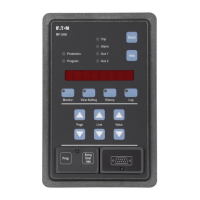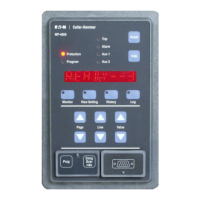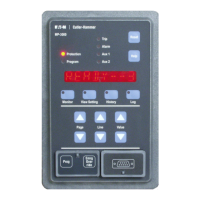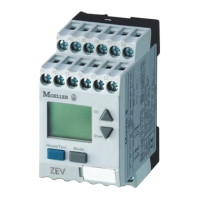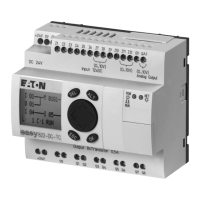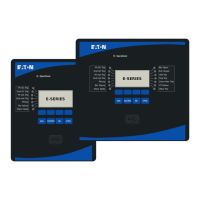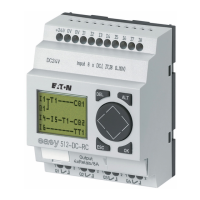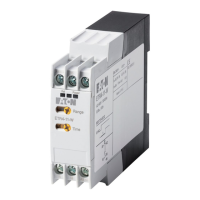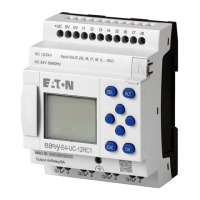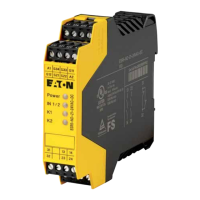IM02602002E
Page 5-8
www.eaton.com
MP-3000
If the zero speed switch (ZSW) function is ON in the SP START page
(P5L11), this DI 1 input is automatically congured to be zero speed
switch contact input, ZERO SW, and no other setting option is visible.
If ZSW is set to OFF, the available choices for Discrete Input 1 are:
REM RST - Remote Reset - When voltage is applied, the MP-3000
resets its active functions and displays, just as if the reset pushbutton
on the faceplate was pressed.
When voltage is applied, the MP-3000
trips the motor and displays the message “REMOTE”. The trip resets
only if the input voltage is removed.
When voltage is applied, the MP-3000
trips the motor and displays the message “DIF TRIP”. This is used with
an external motor differential relay whose trip contact is normally open,
but closes when it detects a fault. The trip can be reset only after the
voltage is removed. It can be used for tripping by any auxiliary function
with a normally-open contact.
With this setting, a
voltage input to DI 1 keeps the MP-3000 in the RUN mode, even when
the motor current drops below 100 mA secondary. This feature is used
mainly with a synchronous motor operating as synchronous condens-
er, for power factor correction. The current may approach zero during
normal sustained operation.
With this setting, the MP-3000 front panel
Reset pushbutton is disabled following a trip or alarm condition. The
only way to reset the unit is to apply voltage to DI 1. This feature pre-
vents unauthorized personnel from resetting the relay or restarting the
motor after a trip. Use a secure reset contact to apply voltage to DI 1.
he DI 1 input will mimic the
functionality of the Emergency Override pushbutton.
This page contains the single setting which congures Discrete Input
2 (DI 2). The input must be a 120 Vac signal. A 120 Vac source for
wetting dry contacts is provided on the MP-3000 terminal block. Refer
to the wiring diagrams in Section 6.
If the incomplete sequence function INSQ is on and set for some time
delay (setting P5L8), DI 2 is automatically congured to control incom-
plete sequence timing, INC SEQ, and no other setting is possible.
If INSQ is turned OFF, the other choices for DI 2 are available. These are
the same choices as for Discrete Input 1, P6L1, covered in Subsection
5.6.1.
Use Page 8 to congure which events activate the alarm relay.
The factory default setting is for every alarm event to activate the alarm
relay and for the alarms to reset automatically when the condition
disappears. Trip events do not activate the alarm relay; nor does Time
Between Starts blocking, which frequently goes true during normal oper-
ating cycles. Check the settings to be sure they agree with the factory
dened values (the Values as Shipped column in Table 4.3) or change
them as needed.
Even though a particular alarm condition is directed to the
alarm relay on this page, it can function only if it is turned on
in the SP ALARM Page 4.
Settings control the following 22 alarm assignments. Any or all can be
turned OFF:
Ground fault alarm, or trip
I2T alarm, or trip
Jam alarm, or trip
Under load alarm, or trip
Phase unbalance alarm, or trip
Winding temperature alarm, or trip (with URTD)
Motor bearing temperature alarm, or trip (with URTD)
Load bearing temperature alarm, or trip (with URTD)
Auxiliary temperature alarm, or trip (with URTD)
Starts per time alarm, or trip
Time between starts trip
Individual RTD channel failure alarm
URTD overall communications failure alarm
IOC trip
Phase reversal trip
Incomplete sequence trip
Remote trip (via discrete input)
Differential trip
INCOM (data communications) trip
Transition trip
Zero speed switch trip
Trip bypass (contactor fails to interrupt current after trip)
Use Page 9 to congure the events that will activate the AUX1 output
relay. It also includes the three settings to congure the load shedding
function.
The factory default setting is for a thermal trip (I2T trip) only to activate
this relay. Many users choose to change this. If the load shed function
is turned on, using settings P9L1 to P9L3 as explained in the next
subsection, the relay AUX1 is dedicated to this function and other uses
are not available or visible.
The load shed function provides a contact output signal that the User
connects to the process equipment, to reduce loading on the motor if
it becomes too large. For example, the contact might be used to tem-
porarily stop the ow of heavy materials onto a conveyor driven by the
protected motor. In this way, the MP-3000 tries to alleviate an overload
before it reaches an outright thermal protective trip. When the load is
reduced, the contact returns to the normal state and the process can
resume loading of the motor.
The load shed function, which is active only during the RUN state of
the motor, is congured with settings P9L1, P9L2, and P9L3.
P9L1 sets current level above which the load shed output is activated.
P9L2 sets the current level below which the load shed output is deac-
tivated.
•
•
•
•
•
•
•
•
•
•
•
•
•
•
•
•
•
•
•
•
•
•

